climate control JEEP COMMANDER 2010 1.G User Guide
[x] Cancel search | Manufacturer: JEEP, Model Year: 2010, Model line: COMMANDER, Model: JEEP COMMANDER 2010 1.GPages: 460, PDF Size: 7.11 MB
Page 233 of 460
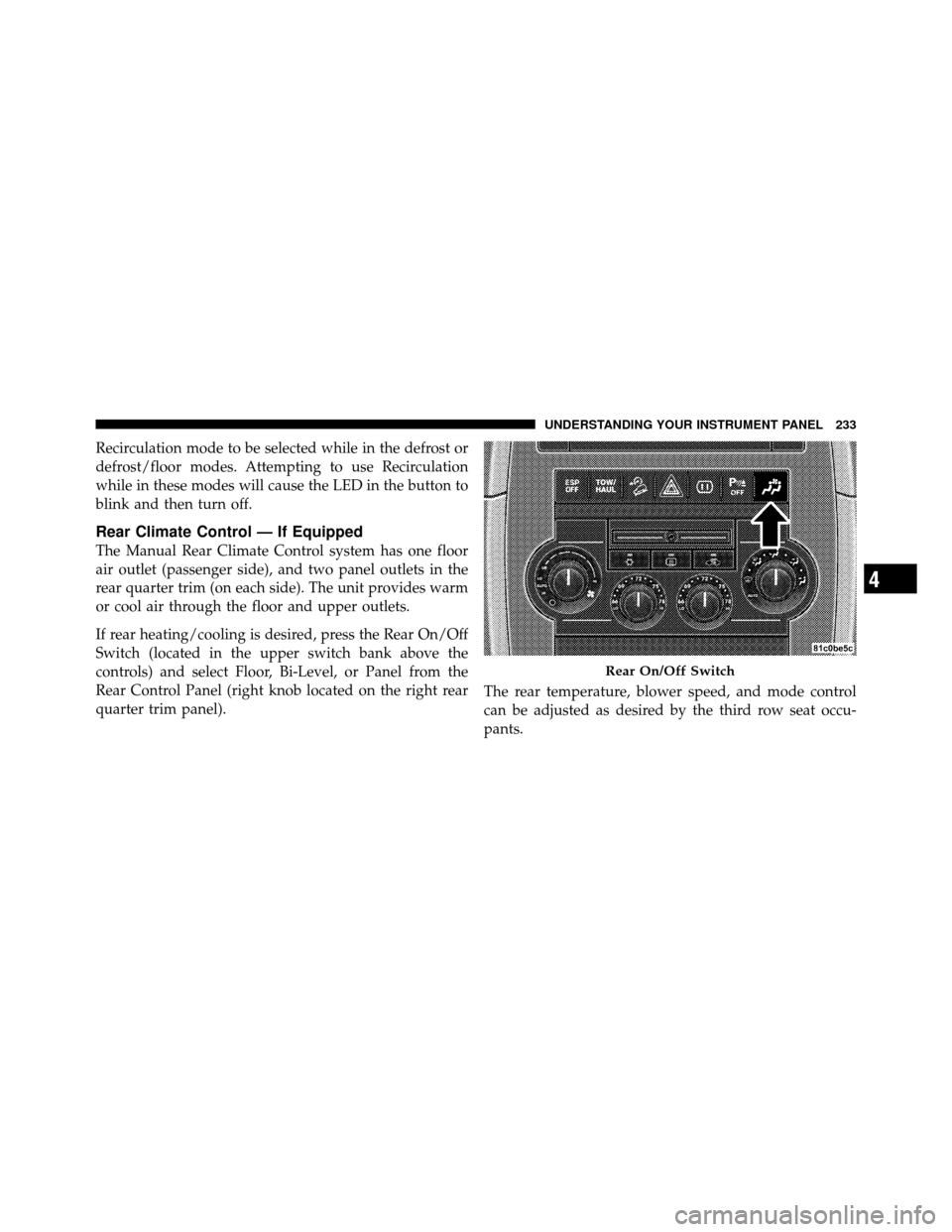
Recirculation mode to be selected while in the defrost or
defrost/floor modes. Attempting to use Recirculation
while in these modes will cause the LED in the button to
blink and then turn off.
Rear Climate Control — If Equipped
The Manual Rear Climate Control system has one floor
air outlet (passenger side), and two panel outlets in the
rear quarter trim (on each side). The unit provides warm
or cool air through the floor and upper outlets.
If rear heating/cooling is desired, press the Rear On/Off
Switch (located in the upper switch bank above the
controls) and select Floor, Bi-Level, or Panel from the
Rear Control Panel (right knob located on the right rear
quarter trim panel).The rear temperature, blower speed, and mode control
can be adjusted as desired by the third row seat occu-
pants.
Rear On/Off Switch
4
UNDERSTANDING YOUR INSTRUMENT PANEL 233
Page 234 of 460
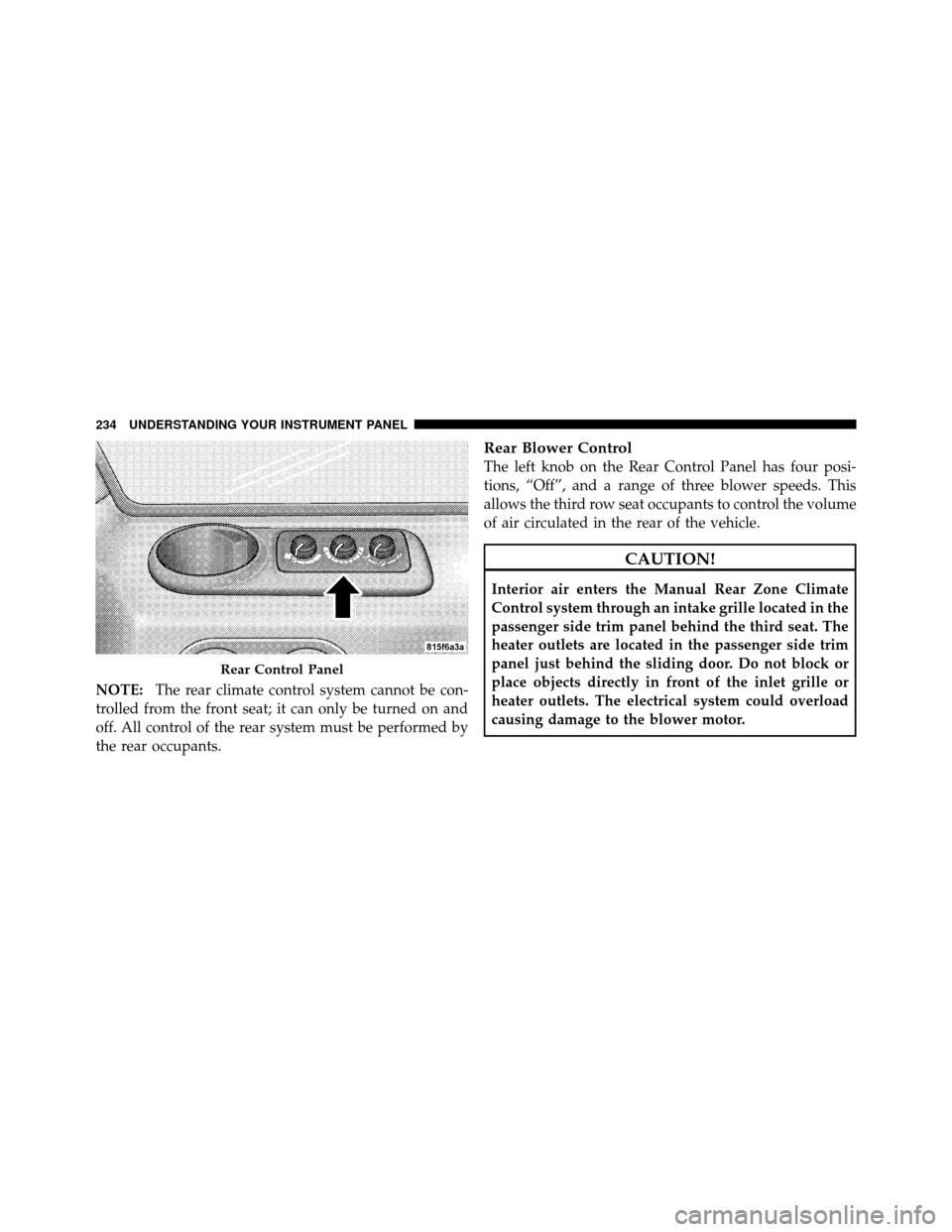
NOTE:The rear climate control system cannot be con-
trolled from the front seat; it can only be turned on and
off. All control of the rear system must be performed by
the rear occupants.
Rear Blower Control
The left knob on the Rear Control Panel has four posi-
tions, “Off”, and a range of three blower speeds. This
allows the third row seat occupants to control the volume
of air circulated in the rear of the vehicle.
CAUTION!
Interior air enters the Manual Rear Zone Climate
Control system through an intake grille located in the
passenger side trim panel behind the third seat. The
heater outlets are located in the passenger side trim
panel just behind the sliding door. Do not block or
place objects directly in front of the inlet grille or
heater outlets. The electrical system could overload
causing damage to the blower motor.
Rear Control Panel
234 UNDERSTANDING YOUR INSTRUMENT PANEL
Page 342 of 460
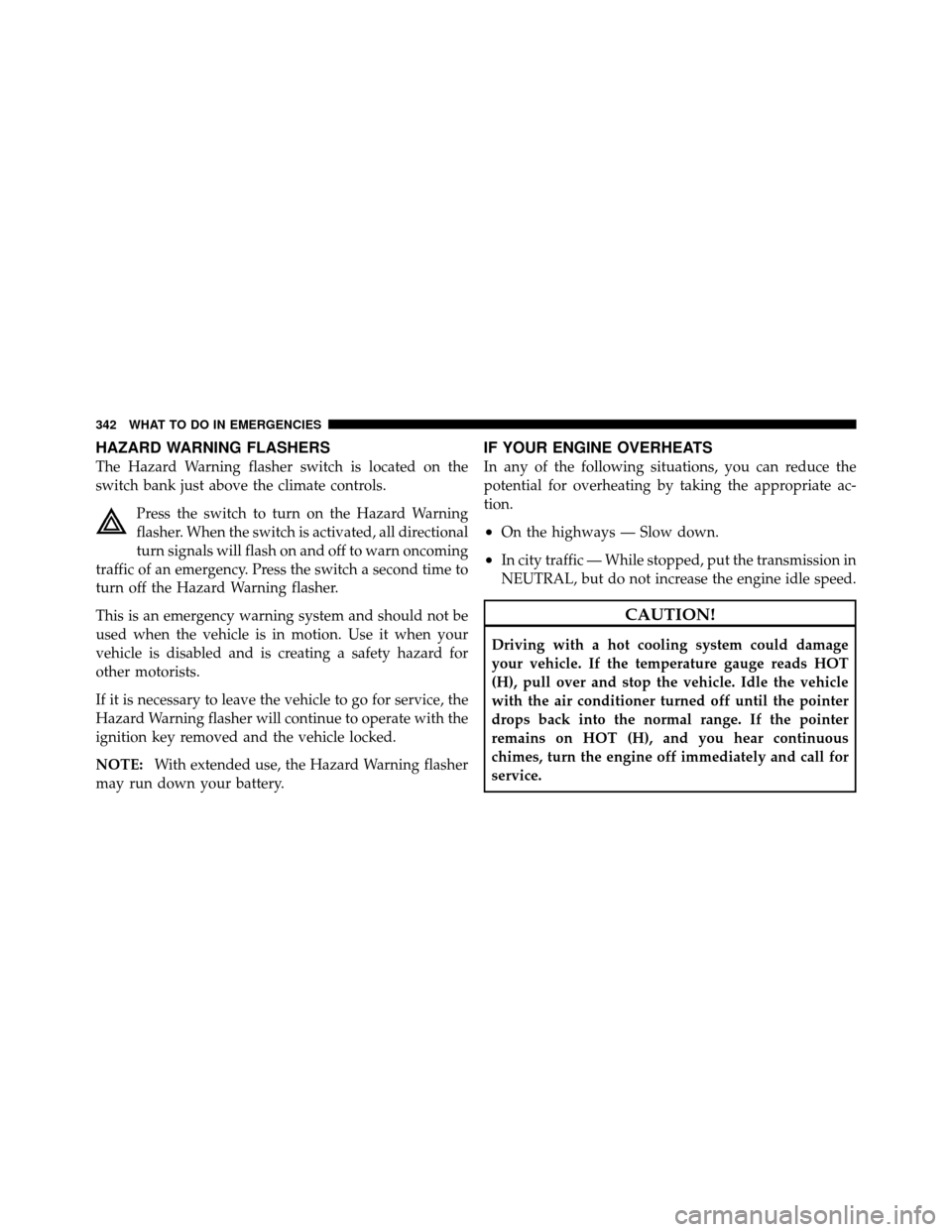
HAZARD WARNING FLASHERS
The Hazard Warning flasher switch is located on the
switch bank just above the climate controls.Press the switch to turn on the Hazard Warning
flasher. When the switch is activated, all directional
turn signals will flash on and off to warn oncoming
traffic of an emergency. Press the switch a second time to
turn off the Hazard Warning flasher.
This is an emergency warning system and should not be
used when the vehicle is in motion. Use it when your
vehicle is disabled and is creating a safety hazard for
other motorists.
If it is necessary to leave the vehicle to go for service, the
Hazard Warning flasher will continue to operate with the
ignition key removed and the vehicle locked.
NOTE: With extended use, the Hazard Warning flasher
may run down your battery.
IF YOUR ENGINE OVERHEATS
In any of the following situations, you can reduce the
potential for overheating by taking the appropriate ac-
tion.
•On the highways — Slow down.
•In city traffic — While stopped, put the transmission in
NEUTRAL, but do not increase the engine idle speed.
CAUTION!
Driving with a hot cooling system could damage
your vehicle. If the temperature gauge reads HOT
(H), pull over and stop the vehicle. Idle the vehicle
with the air conditioner turned off until the pointer
drops back into the normal range. If the pointer
remains on HOT (H), and you hear continuous
chimes, turn the engine off immediately and call for
service.
342 WHAT TO DO IN EMERGENCIES
Page 439 of 460
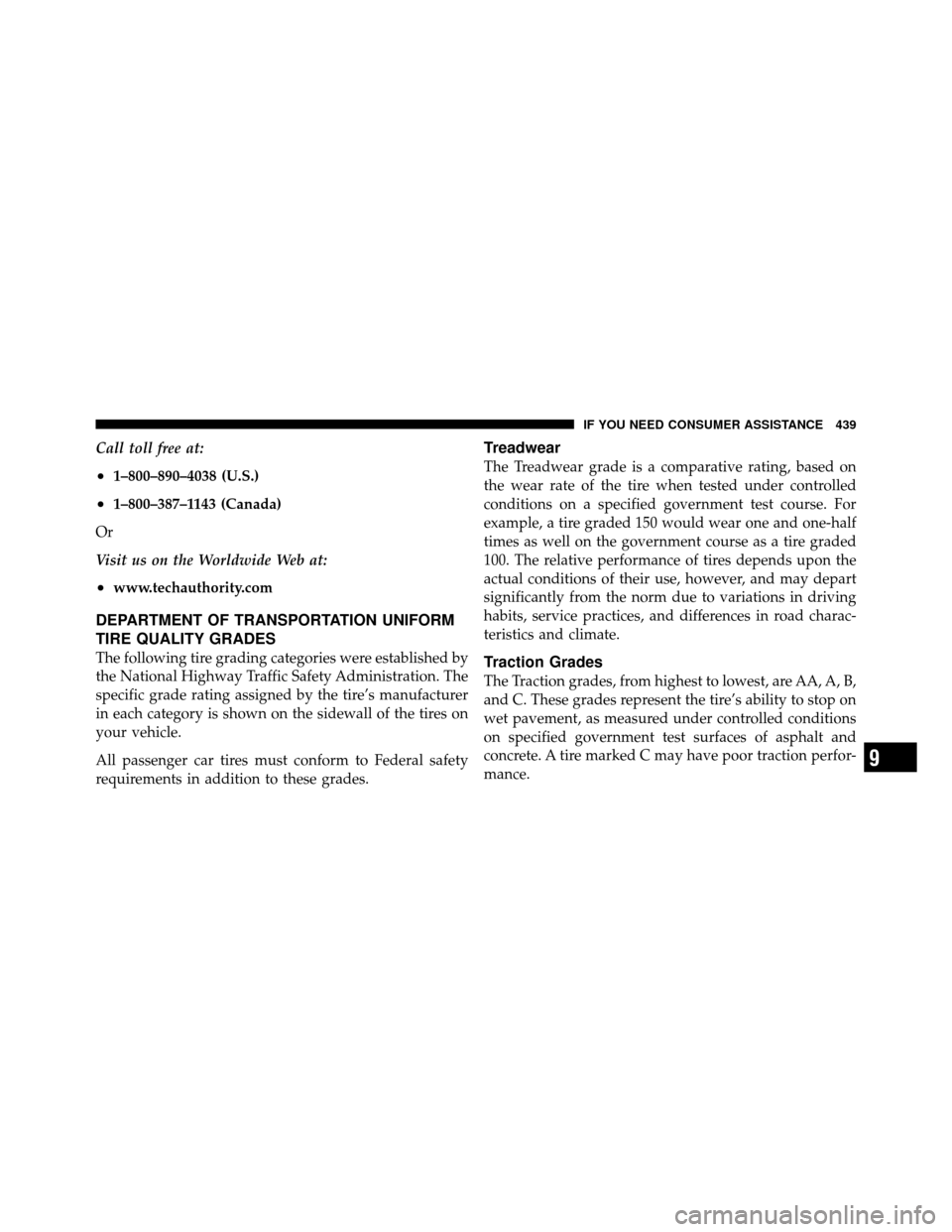
Call toll free at:
•1–800–890–4038 (U.S.)
•1–800–387–1143 (Canada)
Or
Visit us on the Worldwide Web at:
•www.techauthority.com
DEPARTMENT OF TRANSPORTATION UNIFORM
TIRE QUALITY GRADES
The following tire grading categories were established by
the National Highway Traffic Safety Administration. The
specific grade rating assigned by the tire’s manufacturer
in each category is shown on the sidewall of the tires on
your vehicle.
All passenger car tires must conform to Federal safety
requirements in addition to these grades.
Treadwear
The Treadwear grade is a comparative rating, based on
the wear rate of the tire when tested under controlled
conditions on a specified government test course. For
example, a tire graded 150 would wear one and one-half
times as well on the government course as a tire graded
100. The relative performance of tires depends upon the
actual conditions of their use, however, and may depart
significantly from the norm due to variations in driving
habits, service practices, and differences in road charac-
teristics and climate.
Traction Grades
The Traction grades, from highest to lowest, are AA, A, B,
and C. These grades represent the tire’s ability to stop on
wet pavement, as measured under controlled conditions
on specified government test surfaces of asphalt and
concrete. A tire marked C may have poor traction perfor-
mance.
9
IF YOU NEED CONSUMER ASSISTANCE 439
Page 444 of 460
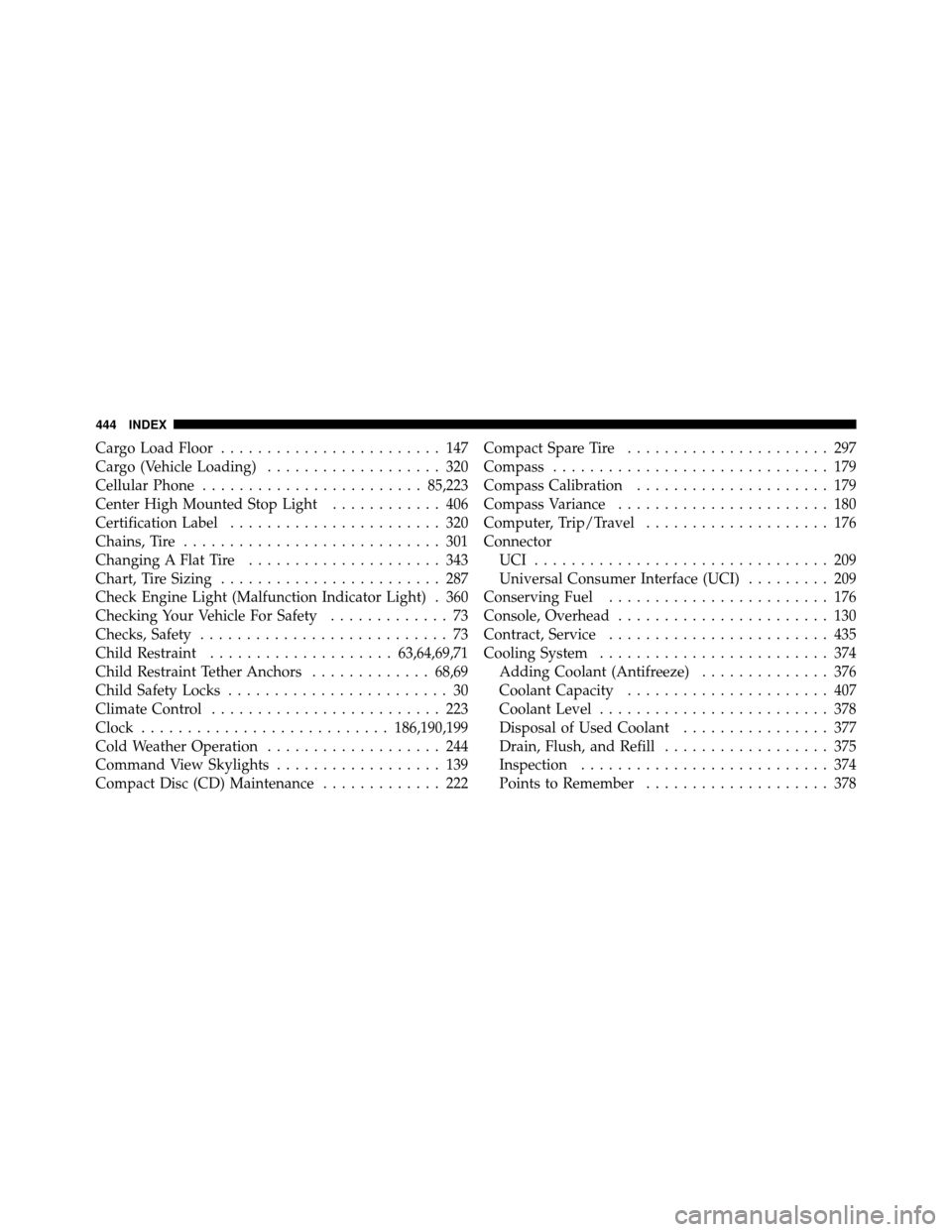
Cargo Load Floor........................ 147
Cargo (Vehicle Loading) ................... 320
Cellular Phone ........................ 85,223
Center High Mounted Stop Light ............ 406
Certification Label ....................... 320
Chains, Tire ............................ 301
Changing A Flat Tire ..................... 343
Chart, Tire Sizing ........................ 287
Check Engine Light (Malfunction Indicator Light) . 360
Checking Your Vehicle For Safety ............. 73
Checks, Safety ........................... 73
Child Restraint .................... 63,64,69,71
Child Restraint Tether Anchors .............68,69
Child Safety Locks ........................ 30
Climate Control ......................... 223
Clock ........................... 186,190,199
Cold Weather Operation ................... 244
Command View Skylights .................. 139
Compact Disc (CD) Maintenance ............. 222Compact Spare Tire
...................... 297
Compass .............................. 179
Compass Calibration ..................... 179
Compass Variance ....................... 180
Computer, Trip/Travel .................... 176
Connector UCI ................................ 209
Universal Consumer Interface (UCI) ......... 209
Conserving Fuel ........................ 176
Console, Overhead ....................... 130
Contract, Service ........................ 435
Cooling System ......................... 374
Adding Coolant (Antifreeze) .............. 376
Coolant Capacity ...................... 407
Coolant Level ......................... 378
Disposal of Used Coolant ................ 377
Drain, Flush, and Refill .................. 375
Inspection ........................... 374
Points to Remember .................... 378
444 INDEX